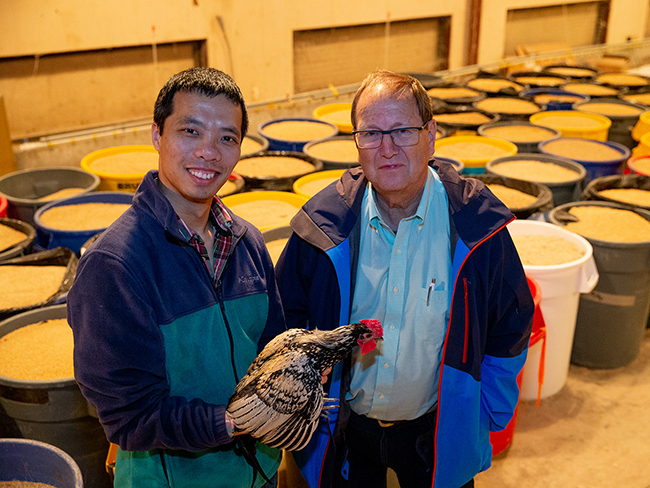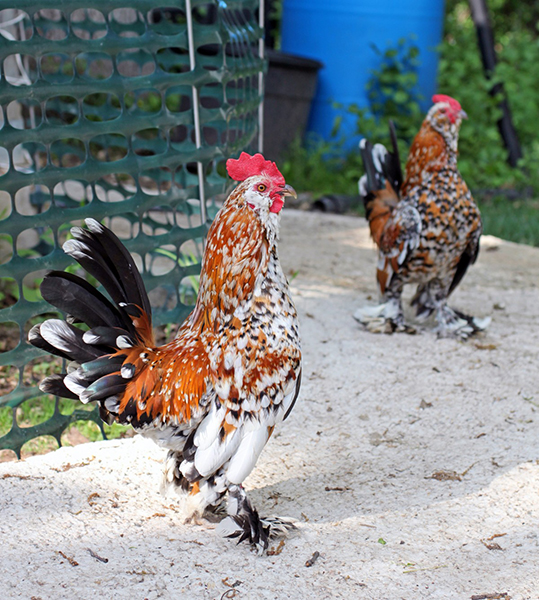CVM Researcher Finds Chickens, Pigeons Share Mutation For Feathered Feet
Story by Margaret Preigh, CVMBS Communications

A team of researchers including Dr. Leif Andersson, a professor at the Texas A&M College of Veterinary Medicine & Biomedical Sciences (CVM), has found that parallel evolution between domesticated chickens and pigeons has resulted in regulatory mutations in the same genes that govern foot feathering in both species.
Poultry geneticists have long studied the inheritance of a prized fancy chicken breeding trait—feathered legs.
The foot feathering trait in question, known scientifically as ptilopody, can be observed in domesticated and wild avian species and is characterized by the partial or complete development of feathers on the skin of the ankles and feet.
“Foot feathering is an interesting case since, although it is a very recognizable trait that can be very easily selected to fixation in breeds, it is, in fact, not a monogenic trait, caused by a single gene,” Andersson said.
In evolution, parallel evolution is known as the independent development of similar physical traits in separate but related lineages. In other words, when faced with adaptation, nature can go to the same “genetic toolbox” to come up with new solutions.
In a study published April 28th in Molecular Biology and Evolution, Andersson and co-authors report that the same two genes, Tbx5 and Pitx1, responsible for foot feather patterning in pigeons are also responsible for foot feather patterning in domesticated chickens.
Andersson and his colleagues set out to find which genes and specific mutations correspond to two previously studied alleles, or gene variants, known as Pti-1 and Pti-2, which have been previously found to contribute to foot feathering in chickens—and if these corresponding genes and mutations were the same as those previously identified as governing foot feathering in pigeons.
They employed controlled breeding to generate a three-generation mapping population of chickens, with a mix of feathered and “clean” legs. The research team then used genetic analysis to spot mutations and genetically characterize 167 chicken populations with or without feathered legs.

“The identification of causal mutations in non-coding parts of vertebrate genomes is challenging, due to the difficulty in deducing or experimentally proving functional significance,” Andersson said. “Here we have presented strong genetic evidence for causality for two non-coding mutations affecting the feathered leg phenotype in domestic chicken using a very large data-set from chicken with or without feathered legs.”
Thus, not only are the same genes involved in foot feathering phenotypes in pigeons and chickens, but the nature of the mutations are also very much the same, at least in the case of Pitx1.
The study reveals a remarkable convergence in the evolution of the feathered leg phenotype in domestic chickens and domestic pigeons as this trait is caused by non-coding mutations in the regulatory instructions of the same two genes. The results show that ptilopody has evolved by running on separate but parallel tracks in chicken and pigeon.
“These two cases add to a growing list of regulatory mutations controlling phenotypic traits in domestic animals by altering the expression of important transcription factors,” Andersson said. “The present study also illustrates that novel phenotypic traits in domestic animals are often caused by the same mutations across divergent populations because favored mutations have been spread from population to population due to strong phenotypic selection.”
This study can also help future researchers by providing a road map for how to identify causal mutations from large datasets and by providing gene candidates that warrant further investigation in regard to leg feathering and other traits in different species.
“The extensive collection of whole genome sequence data, which is publicly available provides a powerful resource to identify genomic regions and corresponding causal mutations associated with these phenotypes as successfully accomplished in this study,” Andersson said.
“Furthermore, feathered legs occur in many other bird species, for instance, in most owls but not in all. If you would like to study the genetic basis for variation in leg feathering within a species or between closely related species, Tbx5 and Pitx1 are the obvious candidate genes to start with.”
###
For more information about the Texas A&M College of Veterinary Medicine & Biomedical Sciences, please visit our website at vetmed.tamu.edu or join us on Facebook, Instagram, and Twitter.
Contact Information: Jennifer Gauntt, Director of CVM Communications, Texas A&M College of Veterinary Medicine & Biomedical Sciences; jgauntt@cvm.tamu.edu; 979-862-4216


